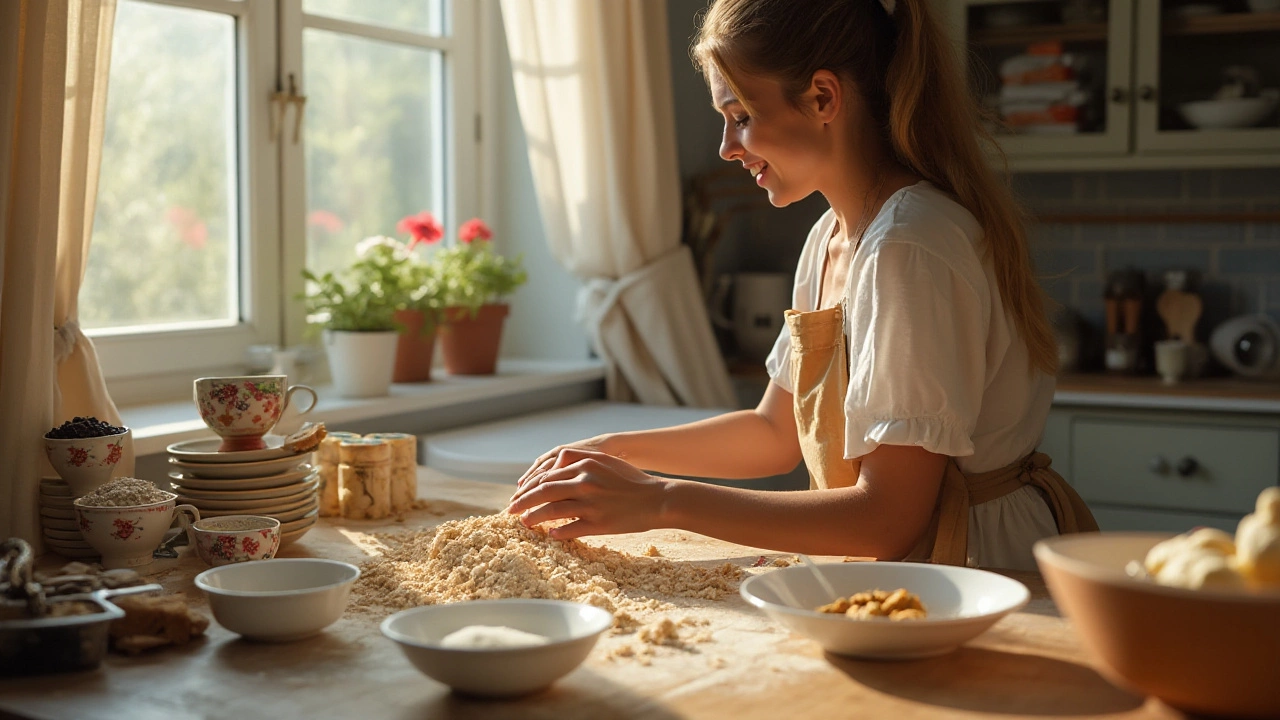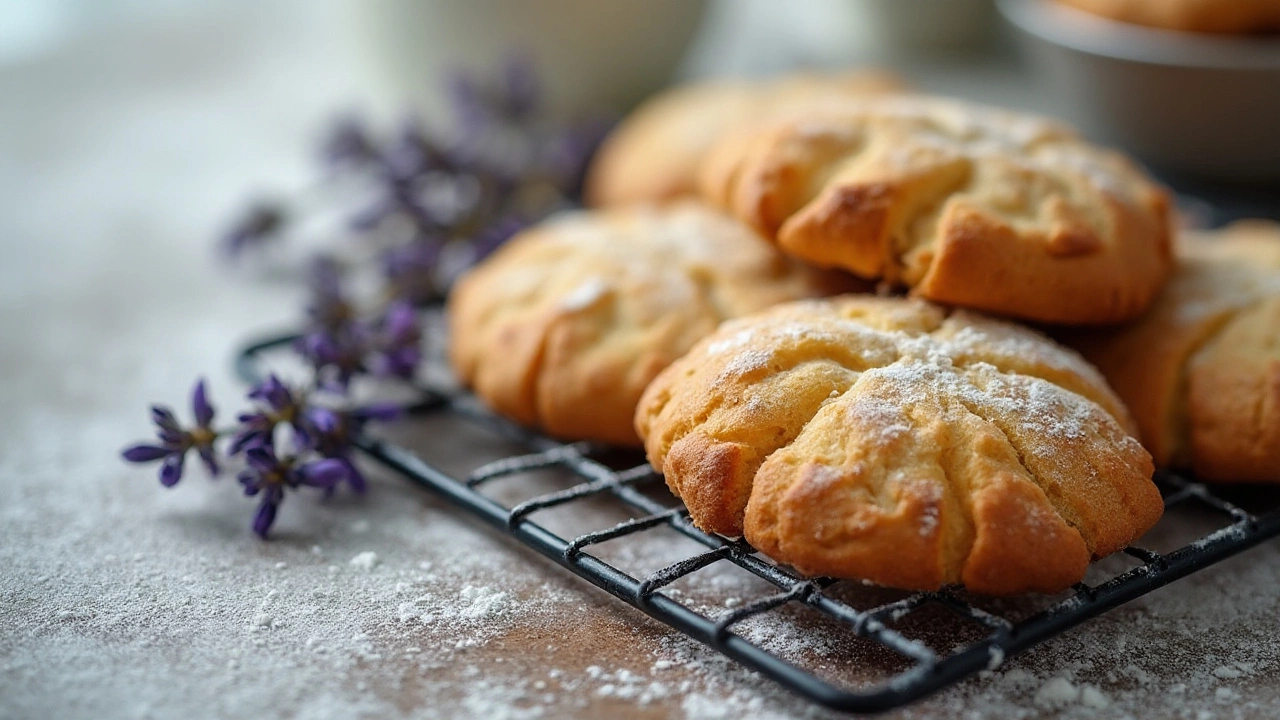
Cookies are a delightful treat, but many recipes call for all-purpose flour, which might not always be at hand. Fear not, because your pantry staple—plain flour—can be a hero in your baking exploits. Whether you're an experienced baker or a kitchen newbie, using plain flour can be your go-to solution for crafting those scrumptious cookies.
When we talk about flour choices in baking, it comes down to gluten content, which affects the texture and spread of your cookies. Plain flour, being a lower-gluten flour, provides a unique texture that savvy bakers have learned to love. The trick is in the technique and balancing other ingredients to bring out the best possible creation.
So, how can you make plain flour work just like the all-purpose kind in your cookie recipes? It’s about understanding adjustments and substitutions while keeping in mind the science of baking. Let’s venture into the world of cookies and discover how plain flour can transform your next baking session!
- Understanding Plain Flour
- Cookie Recipe Adjustments
- Tips for Perfect Texture
- Flavor Variations with Plain Flour
Understanding Plain Flour
Many budding bakers might wonder why plain flour is a significant contender in the baking arena. At its core, plain flour is simply flour that has been milled from wheat grains, minus the bran and germ. This gives it a fairly high starch content along with a moderate protein level, usually around 8-11%. This protein level influences gluten formation, the key factor in determining how airy or firm your bake will come out. Now, that may sound pretty scientific, but the translation into your kitchen is simple: it affects the texture of your cookies profoundly. With plain flour, cookies tend to be more tender and may spread a bit more due to lower gluten. This can result in a melt-in-your-mouth texture when precisely managed with the right amounts of butter and sugars.
One might ask—how does plain flour differ from all-purpose flour? While both are commonly used in households, all-purpose flour is a bit of an upgrade in terms of protein content, often sitting at approximately 10-13%. This slight difference might seem negligible but is quite meaningful when it comes to baking’s intricate chemistry. Foods like cookies, cakes, and pastries benefit from plain flour’s lower gluten content, which allows for a more tender bite rather than a chewy texture. Nonetheless, it’s worth noting that not all baked goods excel under the reign of plain flour; bread, for instance, thrives on higher gluten levels for that iconic chewy, elastic crumb.
Did you know that the origins of flour milling practices can be traced back over 30,000 years? It's fascinating to consider how ancient civilizations depended on basic grinding techniques to produce flour, shaping their diets and, essentially, culinary culture as we know it. Fast forward to modern kitchens, and technology has afforded us consistent quality and texture that bakers can rely on. In some regions, plain flour is referred to as 'soft' flour due to its lower gluten. This regional naming can cause confusion among bakers who traverse different parts of the world or access varying online recipes. Nonetheless, understanding the flour's properties helps in navigating these nuances effectively.
"Flour, the silent performer of the kitchen, drives not just texture but imparts subtle flavor distinctions that can elevate or subtly embrace other ingredients." - Emphasizing the transformative power of flour, renowned baker and author Dan Lepard often highlights the understated yet pivotal role of quality ingredients in creating memorable baked goods.
Practical bakers often have tips up their sleeves to maximize the use of plain flour in cookie recipes. Incorporating baking powder or baking soda can counteract its low gluten by encouraging a bit more puffiness while retaining its tender texture. Moreover, some recipe enthusiasts suggest slightly chilling the cookie dough before baking. This simple technique helps to reduce excessive spreading, leading to cookies that maintain their more delightful shape and chew. Exploring substitutes such as corn flour or almond meal, you can experiment with varied textures, each bringing a unique twist to your cookie outcomes.

Cookie Recipe Adjustments
Baking cookies with plain flour can be a real game-changer, and it requires just a bit of tweaking to get it right. For starters, plain flour doesn't have the same protein content as all-purpose flour, which directly impacts the gluten structure in your cookies—this is the part that contributes to the chewiness and structure of cookies. By understanding these differences, you can make some simple adjustments that will keep your cookies deliciously tender and slightly crumbly, a texture that many find irresistible.
One of the key adjustments is in the sugar mix. Depending on the recipe, you might want to increase or decrease the sugar slightly, as it not only contributes to taste but also to the moisture content. The balance between brown sugar and granulated sugar is especially crucial—brown sugar adds moisture and tenderness, thanks to its molasses content, which can balance out the lower protein in plain flour. An insightful recommendation from baking experts suggests maintaining a higher ratio of brown sugar to amplify that soft, chewy texture we all crave in a perfect cookie.
Another area to watch out for is the leavening agents. A great rule of thumb is to experiment with the baking soda and baking powder quantities, as they help your cookies rise and form a delightful texture. Since plain flour doesn’t develop gluten as robustly as its all-purpose counterpart, increasing the baking soda slightly can assist in achieving a nice, gentle puffiness. But caution here—not too much unless you want your cookies overly fluffy or, worse, bitter.
The Role of Liquid and Fat
Adding liquids such as milk or eggs can make a difference when working with plain flour. These additions help compensate for the lower gluten formation typical with plain flour. An increase in egg yolks can also work wonders; they contribute richness and additional structure. Moreover, the choice of fat—whether butter or shortening—plays a pivotal role. Butter, with its better flavor profile, might reduce the cookie’s thickness, creating a crisp edge and soft center, especially interesting for those classic chocolate chip recipes. An extra tablespoon of butter can enhance both flavor and spread, creating a delightful contrast of textures.
“Baking is all about understanding the science. Once you understand how various ingredients interact, you can tweak any recipe to create a masterpiece.” – Renowned Pastry Chef, Claire Ptak
The beauty of cookie baking is in the flexibility and creativity it allows. So don't hesitate to test variations with different flavors and textures until you find the perfect combination that tickles your taste buds. The golden rule here is patience—sometimes even small changes lead to big improvements. And as with any new baking endeavor, practice makes perfect!
For those curious about blending other flavors with plain flour cookies, consider a touch of cinnamon or nutmeg into the dough for a comforting, spicy note. Experiment with infusions like vanilla or almond extract for aromatic undertones that'll fill your kitchen with warmth and intrigue everyone’s senses. Embrace your inner baker and let your imagination guide your hands in crafting the most delightful treats your loved ones will savor.

Tips for Perfect Texture
When crafting homemade cookies, one often underestimated element is the texture, which can elevate the cookies from ordinary to extraordinary. The use of plain flour offers an excitingly unique feel that differs from the standard cookie recipes that call for all-purpose flour. Achieving the perfect chew or crunch requires attention to details such as the blending of ingredients, baking time, and even cooling processes. First and foremost, remember that plain flour contains less protein than all-purpose flour, leading to a more tender dough. This can work wonders when aiming for a softer cookie, but adjustments are crucial.
One tip is to add a pinch more baking powder or soda to compensate for the lower protein content in the plain flour. This can assist in giving your cookies the right lift and lightness. Sugar plays a critical role in texture, acting not just as a sweetener but also affecting moisture retention. Brown sugar, for instance, adds moisture and creates chewy textures, contrasting with the dryness that white sugar can sometimes produce. Consider incorporating mostly brown sugar for an indulgent chew that plain flour can fully embrace.
Handle your dough gently! Overmixing can develop the gluten network too much, even in a lower-gluten flour like plain flour, making your cookies denser than desired. Once you've formed a dough, a rest in the fridge allows the flour to absorb moisture more evenly, leading to a consistent texture when baked. Watches like baking time and evenness of heat distribution are pivotal—too long and you risk losing that delightful chewiness; too short, and they might be rawish at the center.
"The magic of cookie texture is balanced in the delicate dance between crisp and chewy, where ingredient chemistry plays the lead." —Famed pastry chef Anna Olson.When considering the texture of your cookies, remember that a balance of both crunch and tender chew can be achieved with thoughtful additions and a light hand in mixing. Nuts, for example, can add a pleasing crunchy surprise, while a bit of cornstarch can make your cookies extra soft and melt-in-your-mouth. Tailoring these tips to your taste will make every batch an adventure in homemade cookie goodness with plain flour at the heart of your baking journey.

Flavor Variations with Plain Flour
Using plain flour doesn't mean your cookies have to be plain in terms of flavor. In fact, it's quite the opposite. With a few creative tweaks and thoughtful ingredient pairings, plain flour can serve as a versatile foundation to a wide range of flavorful cookies. One method is to play with the cookie recipes themselves, encouraging variations that enhance and complement the core dough. Consider incorporating elements like spices, extracts, and mix-ins to create unique profiles. Cinnamon or nutmeg can lend a warming touch, perfect for winter treats. Adding a hint of vanilla or almond extract elevates the dough's base flavor, resulting in a richer cookie.
Another effective strategy is to explore sweet and savory combinations. If you're feeling adventurous, incorporate herbs like rosemary with chocolate chips for a sophisticated twist. Or, try integrating citrus zest, such as lemon or orange, for a fresh and zesty aroma. These small yet impactful choices can transform your basic homemade cookies into a gourmet affair. Speaking of mix-ins, the realm of textures can also be enhanced through additional ingredients like nuts, seeds, or dried fruits, offering not just flavor but a delightful crunch or chewiness to contrast the cookie's buttery softness.
Customization doesn't stop with what's in the dough. Consider post-baking enhancements like glazes, drizzles, or even a sprinkle of sea salt on top of chocolate cookies, which can achieve a perfect balance between sweet and salty. Depending on your audience or occasion, you could even prepare batches with varied coatings or toppings. This practice allows for a personalized treat that caters to different palates, making your cookie batch a versatile offering for family gatherings or friendly get-togethers. An interesting point to note from baking enthusiasts is the increasing trend of incorporating artisan ingredients, giving plain flour, often seen as unassuming, a chance to bask in the spotlight of high-quality culinary creations.
"Baking is an art, but it's also a science; plain flour has the unique ability to be a chameleon in your mixing bowl," suggests culinary expert Sarah Anderson.
To inspire further, here's a simple table showcasing potential flavor pairs and their effects on your cookies:
| Flavor Pair | Effect on Cookies |
|---|---|
| Orange Zest and Dark Chocolate | Zesty, vibrant, and sophisticated |
| Cardamom and Pistachio | Warm, nutty, and spice-complex |
| Lavender and Honey | Floral, sweet, and slightly herbal |
| Ginger and Molasses | Bold, spicy, and comforting |
Lastly, don't underestimate the role of color and presentation in making your plain flour cookies stand out. Vivid ingredients like matcha or beetroot powder can add appealing hues to your cookies, encouraging people to indulge with their eyes as well as their taste buds. Playing around with cookie cutters and presentation can also bring forth creative outcomes. Especially during festive seasons, shaping your cookies can significantly enhance their attractiveness and personal touch. The humble plain flour, therefore, has the vast potential to act as a canvas for a myriad of flavors, textures, and presentations, letting your imagination run wild in the world of baking.